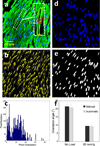Microstructural constitutive model of active coronary media
- PMID: 23859656
- PMCID: PMC4012690
- DOI: 10.1016/j.biomaterials.2013.06.035
Microstructural constitutive model of active coronary media
Abstract
Although vascular smooth muscle cells (VSMCs) are pivotal in physiology and pathology, there is a lack of detailed morphological data on these cells. The objective of this study was to determine dimensions (width and length) and orientation of swine coronary VSMCs and to develop a microstructural constitutive model of active media. The dimensions, spatial aspect ratio and orientation angle of VSMCs measured at zero-stress state were found to follow continuous normal (or bimodal normal) distributions. The VSMCs aligned off circumferential direction of blood vessels with symmetrical polar angles 18.7° ± 10.9°, and the local VSMC deformation was affine with tissue-level deformation. A microstructure-based active constitutive model was developed to predict the biaxial vasoactivity of coronary media, based on experimental measurements of geometrical and deformation features of VSMCs. The results revealed that the axial active response of blood vessels is associated with multi-axial contraction as well as oblique VSMC arrangement. The present morphological database is essential for developing accurate structural models and is seminal for understanding the biomechanics of muscular vessels.
Keywords: Biaxial vasoactivity; Coronary artery; Deformation; Morphology; Vascular smooth muscle cell.
Copyright © 2013 Elsevier Ltd. All rights reserved.
Figures





References
-
- Azuma T, Hasegawa M. A rheological approach to the architecture of arterial walls. Jpn J Physiol. 1971;21:27–47. - PubMed
-
- Azuma T, Oka S. Mechanical equilibrium of blood vessel walls. Am J Physiol. 1971;221:1310–1318. - PubMed
-
- Oka S, Azuma T. Physical theory of tension in thick-walled blood vessels in equilibrium. Biorheology. 1970;7:109–117. - PubMed
-
- Clark JM, Glagov S. Transmural organization of the arterial media. The lamellar unit revisited. Arteriosclerosis. 1985;5:19–34. - PubMed
-
- Glagov S, Vito R, Giddens DP, Zarins CK. Micro-architecture and composition of artery walls: relationship to location, diameter and the distribution of mechanical stress. J Hypertens Suppl. 1992;10:101–104. - PubMed
Publication types
MeSH terms
Grants and funding
LinkOut - more resources
Full Text Sources
Other Literature Sources

